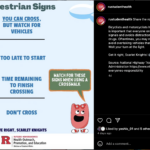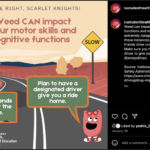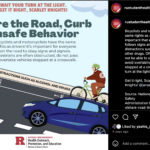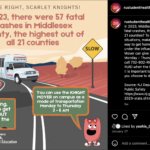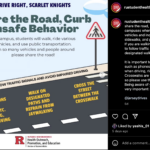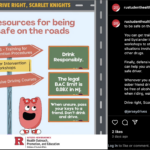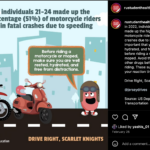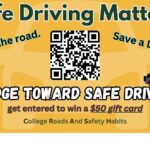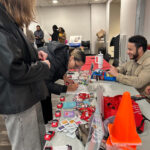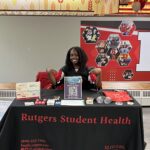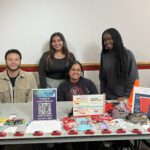Rutgers University – New Brunswick
Drive Right, Scarlet Knights!
How many students heard the message of your project?
300
Project Description:
1.The CRASH Project (College Roads and Safety Habits) focused on educating the Rutgers University-New Brunswick community about impaired driving, riding, and walking risks while promoting safer alternatives such as designated drivers and transportation safety tips to reduce engagement in high-risk behaviors. The campaign emphasized the importance of communicating and disseminating transportation safety messages about driving, pedestrian safety, and alcohol and drug use to the campus community via social media and through outreach efforts. In addition, to complement the project and to engage a broader segment of the target audience we offered a variety of opportunities for the campus community to engage in to learn about the collaboration. We hosted several activities that members of the campus community could participate in such as a focus group, one-to-one conversations, events, and tabling/outreach that addressed risk behavior, risk reduction, and the consequences of alcohol and drug use while walking and/or utilizing various modes of transportation. Our primary objective was to raise awareness about the dangers of driving and/or operating motorized or non-motorized vehicles under the influence of alcohol, drugs (both prescription and illicit), or while drowsy highlighting practical safety alternatives such as designated drivers and rideshare services (e.g. Knight Mover) to encourage responsible behaviors and mitigate possible risks associated with alcohol/drug use and asleep driving. The CRASH team also utilized focus group questions, educational material, and informational sessions, to communicate the message of safe road habits. Pledgers each received education and information about BAC calculators, standard drink sizes, rideshare services on/off campus, campus alcohol and drug resources, drugged/impaired driving, bystander intervention, and safety tips.
School/Community Engagement:
Throughout the project, we worked with different organizations to expand our reach and impact across the campus community. We collaborated with key campus organizations such as the NAACP and Residence Life to co-sponsor events and distribute educational materials. A significant part of our outreach consisted of weekly tabling sessions held in popular areas on campus, which provided an opportunity to engage the campus community in dorms and in multiple student centers. During tabling events, we engaged individuals with materials and interactive elements, including a spinning wheel with CRASH-project related questions, candy to help with outreach efforts, and the promotion of “Sunny” our campaign/university wellness ambassador. We shared promotional items such as a CRASH sticker for laptops and a red Rutgers branded campaign car keychains. This was an integral part of our outreach/engagement efforts because it increased opportunities to reinforce the campaign and promoted the messaging, encouraged pledge participation, introduced campus resources, and increased awareness of our campus transportation safety topic. In addition, our outreach tables featured acrylic stands with the CRASH pledge information, Rutgers Student Health materials, BAC calculators, prescription drug abuse brochures, and drunk goggles to simulate impaired vision. Additionally, our AOD Peer Educators conducted one-to-one conversations during tabling in which they purposefully initiated discussions about impaired driving, riding, and walking. We conducted a focus group and gathered 10 participants to discuss feelings about impaired/distracted driving on campus, what they perceived as the biggest pain points that community members face, and what solutions they believe may be effective. This feedback from the campus community helped tailor our messaging for the project and environmental approaches/interventions to address the specific concerns and needs of the Rutgers community.
Creativity:
Our project is unique because the foundation is based on insights from our target audience and focused on the campus community. In a focus group, participants relayed their thoughts about driving habits, distracted driving, substance use, and outreach activities. Our social media footprint formed an engaging digital arm of the project. At Rutgers, we prioritize the dimensions of wellness, which are represented by custom designed characters. For the campaign, we used Sunny, who represents social wellness and is one of our campus wellness ambassadors. Sunny appears in most of our social media assets to demonstrate how students can be socially safe through tips and resources relating to safe driving, riding, and walking. Our social media posts encompass pedestrian safety, riding safety, driving safety, and tips/resources. To make our digital assets more consistent, we created a slogan: “Driving Right, Scarlet Knights.” This slogan references our mascot and encourages our campus community to adopt safer habits. We used the Rutgers Student Health Instagram to disseminate campaign information. Finally, we created a custom sticker encouraging members of the campus community to avoid mixing driving/walking with substance use. This sticker was designed with insights gained from the focus group that represented members of our campus community. We implemented many of their suggestions and put their recommendations into action to create the most successful outreach campaign. The sticker was distributed to the campus community to remind members of the university about our campaign and its mission to practice safer behaviors and to act responsibly. The sticker encouraged members of our community to request them at tabling events and to use as laptop stickers to promote and support the campaign. In addition to stickers, we distributed custom car-themed stress reliever keychains that also reminded students to drive safely which noted our slogan “Drive Right, Scarlet Knights.
Use of Resources:
We utilized data obtained from our focus group to tailor our campaign to the needs/areas of importance for the university community regarding road safety, as well as their grievances regarding distracted driving on campus. We performed our own research by gathering information via the United States Department of Transportation, National Highway Traffic Safety Administration, and the NJ Department of Law & Public Safety websites, to curate informative social media content to reach members of our campus via Instagram. We gained insightful information to further our knowledge regarding road safety and safe driving practices through a Defensive Driving course by the Rutgers University Public Safety Department and the National Safety Council. Another resource we used were webinars from experts in other fields. A member of our team joined the “Collegiate Impaired Driving – Data Collection Methods & Ohio Results” webinar, which provided valuable insights that directly informed our project approach. Through this training opportunity, we gained a comprehensive understanding of current trends in driving under the influence of alcohol/cannabis among college students. The webinar presented recent statistics and analyses that helped contextualize the scope of the problem on college campuses. The session explored emerging trends related to impaired riding on alternative transportation methods popular on college campuses, including bikes, electric scooters, and skateboards, which broadened our perspective on how substance use affects various forms of mobility on campus. Lastly, we learned about effective techniques for gathering meaningful data on collegiate impaired driving, including survey design, focus group implementation, and analysis of campus safety reports. These methodologies informed how data was collected and interpreted for the project. Lastly, the project was grounded in current research and best practices for outreach and engagement on college campuses.
Evaluation and Impact:
Community engagement was measured through participant involvement in outreach and tabling along with campus events. We tracked and monitored the number of pledges submitted via the QR code in addition to tracking the number of pledges gathered via signatures. We evaluated responses from the questionnaire provided in our focus group and reviewed responses to the questionnaire shared in the focus group meeting. In addition, we conducted knowledge checks, information sessions, and one-to-one sessions for different organizations such as the Rutgers NAACP (National Association for the Advancement of Colored People) and Residence Life. Our team members developed and conducted residence hall events, provided hands-on engagement activities with drunk goggles, and created an obstacle course to provide a simulation of impaired walking and driving behaviors. We also had the CRASH project incorporated into our cannabis and alcohol conduct sessions with the support of the Office of Student Conduct to encourage risk reduction and safe behavior practices amongst members of the campus community. We tracked the number of supplies that were dispersed to the members of the campus community to promote the project. In addition, we tracked the retention of our group members from the commencement to the conclusion of the project to monitor engagement in programming and the various outreach efforts associated with the campaign. Lastly, we tracked the number of outreach and engagement events provided across campuses to communicate and disseminate information about the CRASH Project.
PROJECT MEDIA

